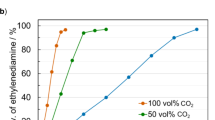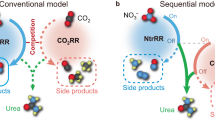Abstract
Urea synthesis, currently the largest use of carbon dioxide in organic synthesis, is conventionally operated at high pressure and high temperature. Here, we report for the first time that urea forms at atmosphere and ambient temperatures by negative corona discharge in gas phase. The conversion of CO2 and yields of a solid mixture of urea and ammonium carbamate, which was identified by the 13C NMR spectrum, rise with reducing temperatures and increasing molar ratios of NH3/CO2 and discharge frequencies. The conversion of carbon dioxide was found to be 82.16 % at 20 °C and 1 atm with a molar flow ratio of n(NH3)/n(CO2) of 2.5. High pressure and high temperature as energy inputs are not necessary.




Similar content being viewed by others
References
Barzagli F, Mani F, Peruzzini M (2011) From greenhouse gas to feedstock: formation of ammonium carbamate from CO2 and NH3 in organic solvents and its catalytic conversion into urea under mild conditions. Green Chem 13(5):1267–1274
Chen J, Davidson JH (2003) Model of the negative DC corona plasma: comparison to the positive DC corona plasma. Plasma Chem Plasma Process 23(1):83–102
Christophorou LG (1984) Electron–molecule interactions and their applications. Academic, New York
Gutsev GL, Bartlett RJ, Compton RN (1998) Electron affinities of CO2, OCS, and CS2. Chem Phys 108:6756–6763
Halmann MM, Steinberg M (1999) Greenhouse gas carbon dioxide mitigation. CRC, Boca Raton
Liu CJ, Mallinson R, Lobban L (1999) Comparative investigations on plasma catalytic methane conversion to higher hydrocarbons over zeolites. Appl Catal A Gen 178(1):17–27
Nielsen RA, Bradbur NE (1937) Electron and negative ion mobilities in oxygen, air, nitrous oxide and ammonia. Phys Rev 51(2):69–75
O’Neill BC, Dalton M, Fuchs R et al (2010) Global demographic trends and future carbon emissions. Proc Natl Acad Sci USA 107(41):17521–17526
Pietruszka B, Heintze M (2004) Methaneconversion at low temperature: the combined application of catalysis and non-equilibrium plasma. Catal Today 90(1–2):151–158
Rienstra-Kiracofe JC, Tschumper GS, Schaefer HF III et al (2002) Atomic and molecular electron affinities: photoelectron experiments and theoretical computations. Chem Rev 102:231–282
Sommerfeld T, Meyer H-D, Cederbaum LS (2004) Potential energy surface of the CO2 − anion. Phys Chem Chem Phys 6:42–45
Spencer LF, Gallimore AD (2010) Efficiency of CO2 dissociation in a radio-frequency discharge. Plasma Chem Plasma Process 31(1):79–89
Stoffels E, Flikweert AJ, Stoffels WW et al (2002) Plasma needle: a non-destructive atmospheric plasma source for fine surface treatment of (bio)materials. Plasma Sources Sci Technol 11(4):304–312
Van Slyke DD, Cullen GE (1914) A permanent preparation of urease, and its use in the determination of urea. J Biol Chem xix:211
Zhukhovitskii DI, Schmidt WF, Illenberger E (2003) Stability of negative ions near the surface of a solid. J Exp Theor Phys 97(3):606–614
Acknowledgments
This work was financed by Shaanxi Important Innovative Projects in Science & Technology of China (2009ZKC04-06) & (2010ZDKG-43), the National Key Technology R&D Program of China (2009BAA20B02), the Key Science and Technology Program of Shaanxi Province of China (2010K01-082), Project supported by the National Natural Science Foundation of China (NSFC21006078), and Interdisciplinary funded projects of Northwest University Postgraduates (09YZZ52).
Author information
Authors and Affiliations
Corresponding authors
Rights and permissions
About this article
Cite this article
Xiang, X., Guo, L., Wu, X. et al. Urea formation from carbon dioxide and ammonia at atmospheric pressure. Environ Chem Lett 10, 295–300 (2012). https://doi.org/10.1007/s10311-012-0366-2
Received:
Accepted:
Published:
Issue Date:
DOI: https://doi.org/10.1007/s10311-012-0366-2




